U.S. Department of Transportation
Federal Highway Administration
1200 New Jersey Avenue, SE
Washington, DC 20590
202-366-4000
Federal Highway Administration Research and Technology
Coordinating, Developing, and Delivering Highway Transportation Innovations
| REPORT |
| This report is an archived publication and may contain dated technical, contact, and link information |
|
| Publication Number: FHWA-HRT-15-049 Date: April 2015 |
Publication Number: FHWA-HRT-15-049 Date: April 2015 |
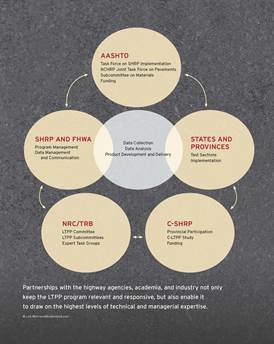 |
| © Luis Molinero/Shutterstock.com |
| Partnerships with the highway agencies, academia, and industry not only keep the LTPP program relevant and responsive, but also enable it to draw on the highest levels of technical and managerial expertise. |
Since its inception, the LTPP program has relied on a close working relationship with many organizations and individuals. The unique blend of expertise among the partners brings focus to every area of the research study. The open and often very candid interaction with the partners has had a positive impact on the program’s direction. The dedication and commitment of those in this partnership arrangement has strengthened the LTPP program and has supported the program’s efforts to provide resources that benefit the highway community.
Since the LTPP program began, partnering with the highway engineering community has been another key to the program’s longevity and success. Even as the program was being planned as part of the Strategic Highway Research Program (SHRP), it benefited from the international outreach and involvement of industry and academia that were integral to the SHRP-LTPP planning process.
In particular, the LTPP program depends on the cooperative efforts of the American Association of State Highway and Transportation Officials (AASHTO), the Canadian Strategic Highway Research Program (C-SHRP), the highway agencies in the States and Provinces, the National Research Council (NRC) through SHRP and the Transportation Research Board (TRB), the Federal Highway Administration (FHWA), and the international highway community. By extension, LTPP partners also include the various paving industries, trucking industry, highway user groups, material suppliers, equipment manufacturers, and the engineers and researchers who use LTPP research results. Each of these partners has played and will continue to play a key role in helping the LTPP program achieve its full potential.
The illustration on the facing page represents the LTPP program’s primary partners (1987 to the present) and their areas of participation, while the summaries below describe how the partners contribute to the program.
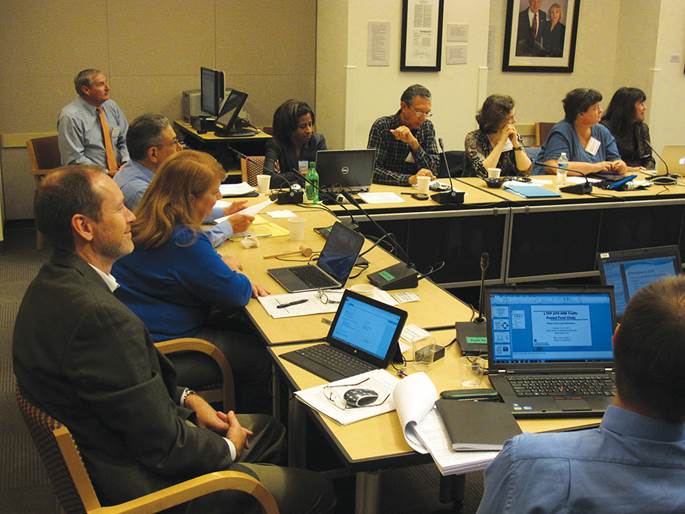 © The Transportation Research Board, www.trb.org |
| Meeting of the TRB Expert Task Group on LTPP Special Activities held in Washington, DC, on October 15, 2013. From bottom left, clockwise: Dean Wolf (Applied Research Associates, Inc.), Rebecca McDaniel, Chair (Purdue University), Robert Raab (TRB), Rick Reel (Florida DOT), Deborah Walker (LTPP Program ), Gary Taylor (Professional Engineer, Michigan), Olga Selezneva (Applied Research Associates, Inc.), Barbara Ostrom (AMEC), and Catherine Lawson (State University at New York). |
|
“ I have had the good fortune to be associated with the Long-Term Pavement Performance program in various ways since its inception. While the extensive database and the many products stand out of course, the importance of partnerships, direct and indirect or implicit, represents both an evolution and a legacy of accrued benefits. State, Federal, and local agencies and researchers are direct beneficiaries. The organizations and the individuals involved have gained experience and expertise, and the state of knowledge and practice has advanced substantially. In turn, the LTPP program itself can justifiably take pride in the many achievements of having more and better trained people in the program and in the partnerships; as well in the receptiveness shown to the needs of the partners. But the ultimate beneficiaries are really the public, who are served by better and safer roads, by skilled people, and by good management of the assets.” Ralph Haas |
AASHTO is the national representative of State transportation agencies in the United States. Through funding from participating agencies, AASHTO lobbies the U.S. Congress on transportation-related issues, conducts national and regional meetings with State representatives on transportation-related topics, publishes materials and testing specifications and standards of practice, and provides reference material services and accreditation to materials testing laboratories.
AASHTO has played a critical role in the LTPP program from its start. From working with States to establish the LTPP program using Federal-Aid highway funds to recruiting test sections to the adoption of LTPP-developed methods, procedures, and guidelines as standards for pavement engineering, AASHTO has provided the collective leadership for many of the program’s successes to date. For example, in 1996, AASHTO passed a Memorandum of Understanding on the LTPP Program, to help in obtaining the remaining Specific Pavement Study (SPS) test sections (figure 3.1). It was not until an AASHTO resolution was passed in April 1998 seeking the States’ help that the effort began in earnest to resolve LTPP data deficiencies identified during a 1996 Program Assessment.1 Likewise, in 2003, LTPP management worked with the AASHTO Subcommittee on Materials to address issues related to the resilient modulus for unbound materials. In addition, through its Standing Committee on Research, AASHTO provided $13.83 million to the LTPP program through the National Cooperative Highway Research Program (NCHRP) to supplement data collection and data analysis activities during a severe funding shortfall (chapter 4). AASHTO was represented on the various SHRP planning committees and the Pavement Performance Advisory Committee, and continues to be represented on the LTPP Committee.
Representatives of Canada were involved with SHRP and the LTPP program from the earliest planning stages. In the spring of 1985, Transport Canada, the country’s national transportation agency, funded a study to explore Canadian involvement in SHRP. Canada’s participation was coordinated by the Roads and Transportation Association of Canada (RTAC) (known as “Transportation Association of Canada” since 1990) through its Council on Highway and Transportation Research and Development.
RTAC worked closely with AASHTO and SHRP, and Provincial officers represented Canada on the SHRP Task Force, SHRP Advisory Committee on Overview and Integration, and on the SHRP technical area advisory committees, including the Advisory Committee on Long-Term Pavement Performance (appendix A), which developed the initial SHRP-LTPP plans. Canada’s highway agencies were also represented in early SHRP workshops in 1985 and 1986, and RTAC conducted meetings and a workshop in the fall of 1985 involving key highway agency and research representatives. In 1986, Canada established its own Strategic Highway Research Program—C-SHRP—with initial funding of $5 million CAD, with 10 percent of the costs covered by the Federal government and the balance by the Provinces.2,3
The Canadian approach to highway research included monitoring SHRP research, pursuing technology transfer related to SHRP and C-SHRP, and conducting two separate research programs:
C-SHRP has played a major role in the achievements of the LTPP program by providing sponsorship and support for LTPP test sections in Canada, supporting LTPP data collection efforts in Canada, participating on the Pavement Performance Advisory Committee and LTPP Committee, and sponsoring LTPP-related data analysis projects. During a period of reduced LTPP program funding, C-SHRP contributed $120,000 to cover digitization of distress survey film and also funded an LTPP publication. Due to Canada’s close support and coordination, it is the only country other than the United States with test section data in the LTPP database.
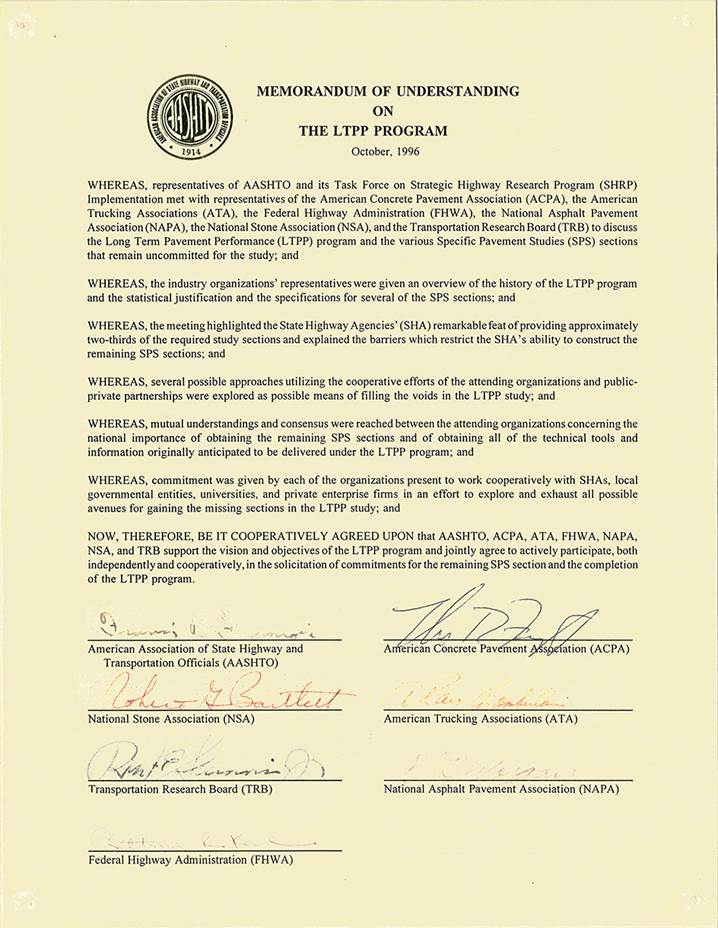 |
| FIGURE 3.1. Memorandum of Understanding for the recruitment of LTPP SPS test sections. |
The LTPP program began as part of SHRP, which was a “State’s” initiative, and it included the departments of transportation for the 50 States, the District of Columbia, and Puerto Rico. These agencies, along with the 10 Provincial transportation agencies of Canada, are both owners and customers of the program.
As owners, highway agencies have made significant investments in the program by investment of funds, designating test sites, constructing and monitoring test sections, supplying test materials, collecting traffic and other data, and providing traffic control. In addition, these agencies have optimized the benefits from their investment in the LTPP program (and their highway networks) by sponsoring and submitting LTPP-related NCHRP research problem statements for data analysis, product development, and implementation activities; participating in LTPP-related pooled fund studies; sponsoring LTPP-related data analysis with agency funds; and participating on AASHTO, TRB, and NCHRP committees, expert task groups (ETGs), and task forces. Many agencies have also loaned staff to work directly with the LTPP program in certain technical areas of the program. These arrangements gave the agency detailed insight about the everyday operations of the program and the opportunity to affect decisions made at the national level.
As customers of the program, the highway agencies are the primary users of the results garnered and yet to be garnered from the program. LTPP data and products are a resource for pavement designers, materials engineers, maintenance engineers, traffic forecasters, and pavement management engineers. For example, the LTPP data will be important to the local and regional calibration of the AASHTOWare® Pavement ME Design software. In addition, with the ready availability of LTPP data via the Standard Data Releases and online support (LTPP InfoPave), agencies can more easily gain access to the data to address their local and regional pavement information/technology needs.
The active participation of highway agencies in the program was largely driven by their expectation that the tools and knowledge that the LTPP program generated would provide answers to issues of importance to them. In formal interviews conducted with chief engineers in the highway agencies as part of the LTPP Program Assessment (chapter 11), the engineers voiced the following expectations:
The States’ concerns echo strongly those cited in the AASHTO Interim Guide for Design of Pavement Structures, known as the “Blue Book,”5 and the Strategic Highway Research Program Research Plans, Final Report, known as the “Brown Book,”6 but have a more tangible feel. In essence, the agencies want useful engineering tools and an enhanced knowledge base on which to base management and engineering decisions—these are their high-priority needs in terms of answers from the LTPP program.
To ensure that general program information and research results are communicated consistently, each of the highway agencies has designated an LTPP State Coordinator, who serves as liaison and point of contact between the agency and the LTPP program staff. Each year during the annual TRB meeting, an LTPP State Coordinators’ meeting is held at which the coordinators learn about the status of the program and LTPP program staff learn how highway agencies are using LTPP data and products at the agency level. Each LTPP State Coordinator has been important to the success of the LTPP initiative.
The highway agencies have been critical to the LTPP program’s achievements and will continue to play a pivotal role in the future. |
As previously discussed, the LTPP program originated and operated for 5 years within SHRP, an independent unit of the National Research Council. From 1987 to 1992, SHRP managed the day-to-day operations of the LTPP program. Specific activities included development of guidelines for recruiting test sections, testing materials, collecting and processing data, establishing the database, and orchestrating and coordinating LTPP activities. The National Research Council also provided peer advisory committees to the LTPP program through SHRP. Later, TRB, a sister entity to SHRP under the National Research Council’s umbrella began operating several committees that have provided an independent forum in which the States, Provinces, industry, and academia have contributed input and advice on the conduct of LTPP research and implementation activities.
As part of the partnership with the LTPP program, TRB has sponsored special LTPP events. In September 2010, for example, the LTPP Committee sponsored an LTPP Pavement Analysis Forum that brought together pavement design, management, preservation, and traffic data experts to update the Strategic Plan for LTPP Data Analysis. Jointly planned and implemented by FHWA’s LTPP Team and the LTPP Committee, the forum was designed to identify, define, and prioritize the analytical studies that will produce results that can be further developed and combined into products that highway agencies can use to help design, build, and maintain—on a mechanistic/empirical basis—existing and future highways.7 In addition, many of TRB’s research projects, such as NCHRP Project 1-37A (Mechanistic-Empirical Pavement Design Guide) and NCHRP Project 1-34D (Effects of Subsurface Drainage on Performance of Asphalt and Concrete Pavements: Further Evaluation and Analysis of LTPP SPS-1 and SPS-2 Field Sections), have been strengthened through the use of LTPP data.
The work of all of the LTPP advisory committees and ETGs exemplifies the dedication of individual stakeholders who have offered advice and provided guidance to the program.
The FHWA has been a prime mover behind the LTPP program, from investing in preliminary research in long-term pavement monitoring in 1984, before SHRP-LTPP began, through its sponsorship and extension of the LTPP program beginning in 1992 and continuing into the future. The agency has provided a permanent “home” for the program by securing the LTPP Information Management System, performance data, and other program products at FHWA’s Turner-Fairbank Highway Research Center, and by continually upgrading the software and hardware required for accurate and reliable data collection and management. The FHWA has also provided budgetary support to supplement congressional authorizations and in-kind staff and overhead throughout much of the LTPP program’s existence.
From the earliest landmarks in the LTPP program’s formative years, a broad range of viewpoints and areas of expertise has been represented on planning and decisionmaking bodies. The “Stars” report, the first official call for SHRP and LTPP, was prepared by a 13-member steering committee that included two academic institutions and two major corporations as well as a county executive and a public policy group. In the formulation of the SHRP Research Plans, although the State and Provincial highway agencies were the predominant groups, university departments of civil engineering and transportation research institutions were also well represented, and engineering firms and trade organizations comprised the balance. The LTPP advisory committees and expert task groups have continued this practice of providing diverse input into program planning and management.
Highway industry and user groups have also been providing input since the beginning of the LTPP program, for example:
The LTPP program has enjoyed a unique partnership with the American Society of Civil Engineers (ASCE). Since 1998, ASCE and FHWA-LTPP have jointly sponsored a series of international contests on LTPP Data Analysis to recognize the use of LTPP data by university students and professors. The contest is designed to encourage university students, professors, and highway department engineers from around the world to get involved in using the LTPP database. ASCE’s participation is managed by its Task Committee on the Long-Term Pavement Performance Contest, which is a subcommittee of the Highway Pavement Committee of ASCE’s Transportation and Development Institute.
The contest usually makes awards in four categories (Undergraduate students, Graduate students, Partnership, and Challenge) with a theme that changes each year. Prizes have included expense-paid attendance at the TRB Annual Meeting, cash awards, and publication of winning papers (figure 3.2).8,9,10
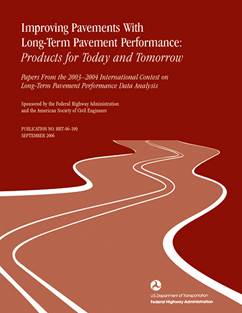 |
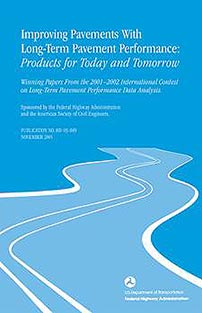 |
| FIGURE 3.2. Reports of the winning papers from the 2001–2002 and 2003–2004 international data analysis contests. | |
Other governments around the world were facing pavement issues similar to those in the United States when the LTPP program was first envisioned. Consequently, SHRP invited collaboration from international highway agencies during the pre-implementation phase to obtain information about research and to solicit suggestions for future cooperation. SHRP also sponsored a number of international workshops and conferences. After the first workshop, held in 1986 in Alexandria, Virginia, SHRP adopted a formal policy of international cooperation, and several other conferences followed. In 1988, LTPP was one of two themes at a SHRP International Technical Workshop held in Bath, England. Delegates representing 17 countries11 exchanged information and plans for data collection testing procedures, information management systems, laboratory accreditation, and other issues related to measuring long-term pavement performance.
By 1994, more than 10 countries were conducting their own LTPP studies, while others were planning to do so, and 30 countries had each identified an international coordinator to facilitate the exchange of information about the LTPP program and pavement research. Researchers from other countries also use LTPP data to address their research needs. Members of highway agencies in many countries have participated in the LTPP loaned staff program (Australia, Canada, Denmark, Finland, France, Germany, Japan, Norway, Romania, Slovenia, South Africa, Sweden, Venezuela, and the United Kingdom during the SHRP years alone)12 and have served as members in one or more of the TRB LTPP committees or ETGs (e.g., Canada, Denmark, Germany, Sweden, The Netherlands, and the United Kingdom). From time to time, international organizations, such as the International Road Federation, Pan-American Institute of Highways, USAID, World Road Association-PIARC, and The World Bank, have also been represented in forums and on committees. International exchange of information and onsite visits have continued throughout the LTPP program.
INTERNATIONAL PARTICIPATION
International Coordinator Meeting, Washington, DC, 1990 Face-to-face meetings were one avenue of participation for the international highway community. The international coordinators reported on their own highway research programs at SHRP-sponsored workshops and TRB’s Annual Meeting and contributed their expertise through on-site staff assignments in Washington, advisory committees, and ETGs. Represented at the pictured meeting were Canada, Australia, Finland, Germany, Sweden, Norway, Austria, Denmark, and the United Kingdom, with others. Participation came from as far as South Africa, Egypt, and Japan. |
The LTPP program has flourished within a cooperative structure that from the program’s beginning has involved the State and Provincial highway agencies, their representative organizations AASHTO and C-SHRP, TRB’s research advisory capacity by way of its advisory committees and ETGs, the participation of professional organizations and researchers from other countries, continuous support from FHWA, a dedicated management corps, and experienced contractor staff. With a commitment to fulfill the program’s goal through changes in management and funding, including financial contributions that are discussed in the next chapter, this productive collaboration among the partners has moved the LTPP program forward for more than 25 years. Continuing these partnerships into the future will assure that the program remains relevant to the needs of highway agencies and the pavement research community.